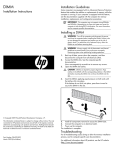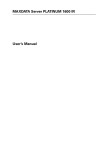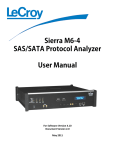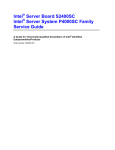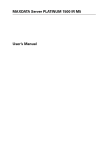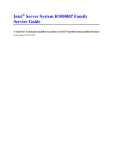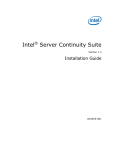Download MAXDATA Server PLATINUM 500 I M8 – User`s Manual
Transcript
MAXDATA Server PLATINUM 500 I System Manual 2 Contents Contents 1 Setting up the System 7 Server Position.........................................................................................................................................7 Connecting the System............................................................................................................................8 Back Panel Connectors.......................................................................................................................8 Front Panel Controls and Indicators.........................................................................................................9 Warning LED.......................................................................................................................................9 HDD LEDs.........................................................................................................................................10 Hard Disk Drive Numbering...............................................................................................................11 2 Server System Features 13 Server Board Connector and Component Locations..............................................................................14 Configuration Jumpers...........................................................................................................................15 Diagnostic LEDs for Light-Guided Diagnostics.......................................................................................15 SSI Front Panel Connector.....................................................................................................................16 RAID Support.........................................................................................................................................17 Hardware Requirements........................................................................................................................17 Processor..........................................................................................................................................17 System Memory................................................................................................................................17 Supported Memory Modules............................................................................................................18 Optional Hardware.................................................................................................................................18 3 Hardware Installations and Upgrades 19 Before You Begin...................................................................................................................................19 Tools and Supplies Needed....................................................................................................................19 Removing and Installing the Front Bezel................................................................................................19 Removing the Chassis Cover.................................................................................................................20 Installing 5.25" Drive (DVD, Streamer)....................................................................................................20 Installing SATA or SAS Hot-Swap Drives...............................................................................................20 Installing and Removing Memory...........................................................................................................22 Installing DIMMs...............................................................................................................................22 Removing DIMMs.............................................................................................................................23 Installing or Replacing a Processor.........................................................................................................23 Installing a Processor........................................................................................................................23 Installing the Heat Sink(s)..................................................................................................................25 Removing a Processor......................................................................................................................26 Installing a PCI Card...............................................................................................................................26 Replacing the Backup Battery................................................................................................................27 Clearing the Password...........................................................................................................................29 Recovering BIOS Defaults......................................................................................................................29 4 Server Utilities 31 Using the BIOS Setup Utility..................................................................................................................31 Starting Setup....................................................................................................................................31 If You Cannot Access Setup..............................................................................................................31 Setup Menus.....................................................................................................................................31 5 Rack Installation 33 Parts List ...............................................................................................................................................33 Installation..............................................................................................................................................34 MAXDATA Server PLATINUM 500 I M8 3 6 Technical Reference 37 Power Supply Specifications..................................................................................................................37 600 W Single Power Supply Input Voltages......................................................................................37 Efficiency...........................................................................................................................................37 600 W Single Power Supply Output Voltages...................................................................................37 620 W Redundant Power Supply Input Voltages..............................................................................37 620 W Redundant Power Supply Output Voltages...........................................................................37 System Environmental Specifications....................................................................................................38 7 Regulatory and Integration Information 39 Product Regulatory Compliance.............................................................................................................39 Product Safety Compliance...............................................................................................................39 Product EMC Compliance ................................................................................................................39 Product Regulatory Compliance Markings........................................................................................39 Product RoHS Compliance................................................................................................................39 Installation Precautions..........................................................................................................................39 Installation Requirements.......................................................................................................................40 Prevent Power Supply Overload.......................................................................................................40 Place Battery Marking.......................................................................................................................40 Use Only for Intended Applications........................................................................................................40 Power and Electrical Warnings...............................................................................................................40 Rack Mount Warnings............................................................................................................................41 4 Contents Figures 1. Back panel connectors.......................................................................................................................8 2. Front controls and indicators..............................................................................................................9 3. HDD LEDs........................................................................................................................................10 4. HDD numbering with 3.5" hot-swap HDDs......................................................................................11 5. HDD numbering with 2.5" hot-swap HDDs......................................................................................11 6. Server board connector and component locations ..........................................................................14 7. Configuration jumpers......................................................................................................................15 8. Diagnostic LEDs for Light-Guided Diagnostics.................................................................................15 9. SSI front panel connector.................................................................................................................16 10.DIMM configuration.........................................................................................................................18 11.Front bezel.......................................................................................................................................19 12.Releasing the drive carrier from a hot-swap cage............................................................................20 13.Securing a hard disk drive to a drive carrier......................................................................................21 14.Inserting a drive carrier into the drive cage......................................................................................21 15.Installing memory.............................................................................................................................22 16.Opening the processor socket lever................................................................................................24 17.Opening the load plate.....................................................................................................................24 18.Removing the protective covering...................................................................................................24 19.Inserting the processor....................................................................................................................24 20.Closing and locking the load plate....................................................................................................25 21.Installing the heat sink......................................................................................................................25 22.Replacing the battery.......................................................................................................................28 Tables 1. NIC LEDs............................................................................................................................................8 2. HDD LEDs on 3.5" bays....................................................................................................................10 3. HDD LEDs on 2.5" bays....................................................................................................................10 4. Server system features....................................................................................................................13 5.LEDs.................................................................................................................................................16 6. Keyboard commands.......................................................................................................................32 7. Efficiency of the 600 W power supply.............................................................................................37 8. 600 W power supply output rating...................................................................................................37 9. 620 W power supply output rating...................................................................................................37 10.Environmental specifications............................................................................................................38 11.Product certification markings..........................................................................................................39 MAXDATA Server PLATINUM 500 I M8 5 6 1 Setting up the System Server Position Please take note of the following criteria for creating a practical and safe workplace when setting up your computer: The system can be used anywhere the temperature is suitable for people. However, rooms with humidity over 70 %, and dusty or dirty areas are not appropriate. In addition, do not expose the server to any temperatures over +30 °C or under +10 °C. Make sure that the cables connecting the server to peripheral devices are not tight. Make sure that all power and connection cables are positioned so that they are not trip hazards. When you save data to your server‘s hard disks or to a floppy disk, they are stored as magnetic information on the media. Make sure that they are not damaged by magnetic or electromagnetic fields. Because the electronics in your computer can be damaged by jarring, no mechanical devices should be placed on the same surface as the server. This is especially important for impact printers whose vibrations could damage the hard disk. Please take care to ensure a free air flow to the server at all times. Do not block the ventilation slots of the server case and particularly the power supplies. An insufficient air flow may damage the server and/or its components. ATTENTION In order to fully separate the server from current, the power cord must be removed from the wall outlet. ATTENTION Safety instruction for upright devices: To ensure stability, the floor stands must be turned outwards. MAXDATA Server PLATINUM 500 I M8 7 Connecting the System Back Panel Connectors Figure 1. Back panel connectors A. Serial port A B. Video port C. NIC 1 (top), two USB ports (bottom) D. NIC 2 (top), two USB ports (bottom) E. Diagnostic LEDs F. ID LED G. Status LED The NIC LEDs at the right and left of each NIC provide the following information: Table 1. NIC LEDs LED LED state Description Left Off No network connection Solid amber Network connection in place Right 8 Blinking amber Transmit/receive activity Off 10 Mbit/s connection (if left LED is on or b linking) Solid amber 100 Mbit/s connection Solid green 1000 Mbit/s connection Setting up the System Front Panel Controls and Indicators At the front of the case, you can find the neccessary controls like power button, reset button and the HDD LEDs. Press the power button one time briefly in order to boot the server. J A B C D E I F G H K L Front door closed Front door open Figure 2. Front controls and indicators A. Power button G. NIC1 LED B. Reset button H. Warning LED C. Warning mute button I. Lock D. Power LED J. Front bezel release slide E. HDD LED K. Recess for opening the front door F. NIC2 LED L. USB ports Warning LED The Warning LED flashes red and the backplane gives an acoustic alarm in the following events: • The backplane exceeds the temperature limit. This may be due to a fan issue. • A fan connected to the backplane has failed. • In a redundant power supply, one of the two modules has failed or is disconnected. MAXDATA Server PLATINUM 500 I M8 9 HDD LEDs The hot-swap HDDs are equipped with LEDs providing information about the current status of the respective HDD. A B Figure 3. HDD LEDs Table 2. HDD LEDs on 3.5" bays Callout LED LED state Description A. Drive bay usage, blue Off Drive bay not in use or HDD powered off On Drive bay in use, HDD powered on HDD state, green On SAS HDD: powered on, no activity Blinking Drive activity: • SAS HDD: LED blinks off when executing commands • SATA HDD: LED blinks on when executing commands Off SATA HDD: no activity B. Table 3. HDD LEDs on 2.5" bays 10 Callout LED LED state Description A. Drive bay usage, blue Off Drive bay not in use or HDD powered off On Drive bay in use, HDD powered on B. HDD state, green/red Solid green SAS HDD: powered on, no activity Blinking green Drive activity: • SAS HDD: LED blinks off when executing commands • SATA HDD: LED blinks on when executing commands Off SATA HDD: no activity Solid red Drive failure Blinking red RAID rebuild in progress Blinking green/red Drive identification Setting up the System Hard Disk Drive Numbering Per default, the HDDs numbers and positions are as follows: • 3.5" hot-swap HDDs The HDDs of each 4x backplane are numbered from bottom to top in ascending order. 3 2 1 0 Figure 4. HDD numbering with 3.5" hot-swap HDDs If two backplanes are in use and both are connected to the same controller, the lower four drive bays are connected to ports 0 to 3, while the upper four drive bays are connected to ports 4 to 7. • 2.5" hot-swap HDDs The HDDs of each 8x backplane are numbered from top to bottom in ascending order. 0 1 2 3 4 5 6 7 Figure 5. HDD numbering with 2.5" hot-swap HDDs MAXDATA Server PLATINUM 500 I M8 11 12 2 Server System Features This chapter briefly describes the main features of the server system. This chapter provides a list of server system features and diagrams showing the location of important components and connections of the server system. Table 4 summarizes the features of the server system. Table 4. Server system features Feature Description Server board Intel® S2400SC2 Processors One or two Intel® Xeon® E5-2400 processors with up to 95 W thermal design power (TDP) System memory • 8 DIMM sockets, 4 per processor • Up to 128 GB system memory using 16-GB LRDIMMs • 1066/1333 MT/s ECC unbuffered (UDIMM) DDR3 memory or 800/1066/1333/1600 MT/s ECC registered (RDIMM) DDR3 memory • Mixing UDIMMs and RDIMMs is not supported • DDR3 standard I/O voltage of 1.5 V and DDR3 Low Voltage of 1.35 V Chipset • Intel® C602 Platform Controller Hub (PCH) with integrated storage controller unit (SCU) • RAID upgrade keys supported for the SCU ports Peripheral interfaces External connectors: • One DB-15 graphics port • One serial DB-9 port A connector • Two RJ-45 network ports for 10/100/1000 Mbit/s • Four USB 2.0 ports on the back panel • Two USB 2.0 ports on the front panel Internal connectors: • One USB connector for two front-panel USB 2.0 ports • One type A USB 2.0 port • One eUSB SSD USB 2.0 header (2 mm pitch) • One DH-10 connector for serial B port • Two SATA III ports (6 Gbit/s) • Four SATA II ports (3 Gbit/s) • Eight SAS/SATA ports with 3 Gbit/s in two MiniSAS connectors (feature activation with RAID upgrade keys; four SATA ports enabled by default) • Remote Management Module 4 network and feature key ports RAID support • Intel® RSTe software RAID 0/1/10/5 • LSI software RAID 0/1/10 (RAID 5 on SCU ports with appropriate activation key) Graphics • On-board Matrox G200 2D video controller • 16 MB graphics memory LAN Two Intel® 82574L Gigabit Ethernet LAN adapters Add-in card slots • • • • • HDD bays • 8 hot-swap 3.5" bays or 16 hot-swap 2.5" bays • Support fort wo internal 3.5" SATA HDDs Power supply Single 600 W power supply or redundant 620 W power supply Fan • Three 92 mm hot-swap fans (chassis center) • One 120 mm fan (chassis back) Server management • • • • 1 × PCIe Gen III x16 (slot 6, von CPU 1) 1 × PCIe Gen III x8 open-ended (slot 5, from CPU 2) 1 × PCIe Gen III x4 with x8 connector (slot 4, from CPU 1) 1 × PCIe Gen II x4 with x8 connector (slot 3, from PCH) 1 × PCI 32 bit/33 MHz (slot 2, from PCH) Integrated IPMI 2.0-compliant baseboard management controller Support for remote management module 4 (“KVM over IP”) Support for system management software Light-Guided Diagnostics on replaceable units (FRUs) MAXDATA Server PLATINUM 500 I M8 13 Server Board Connector and Component Locations CPU 2 CMOS battery CPU 1 Figure 6. Server board connector and component locations 14 A. Slot 2, PCI 32 bit/33 MHz S. Jumper (not in use) AK. SATA port 3 B. Slot 3, PCIe Gen II x4 T. TPM header AL. SATA port 4 C. Slot 4, PCIe Gen III x8 U. LCP header AM. SATA port 5 D. RMM 4 LITE V. System fan 6 header AN. SATA port 0 E. Slot 5, PCIe Gen III x8, open-ended W. HSBP I2C header AO. SATA port 1 F. Slot 6, PCIe Gen III x16 X. System fan 5 header AP. SCU 1 G. DIMM sockets of CPU 2 (channels D, E, F) Y. System fan 4 header AQ. eUSB SSD header H. Diagnostic LEDs Z. ME update jumper AR. RAID upgrade key I. CPU 2 fan header AA. System fan 3 header AS. SCU 0 J. USB and network connectors AB. System fan 2 header AT. Password clear jumper K. Video port AC. SATA SGPIO AU. BIOS recovery jumper L. Serial port A AD. System fan 1 header AV. BMC update jumper M. CPU 2 power AE. PMBus header AW. RMM 4 header N. System fan 7 header AF. HDD LED header AX. Front panel header O. DIMM sockets of CPU 1 (channels A, B, C) AG. Type A USB port AY. USB header P. CPU 1 power AH. IPMB header AZ. Serial port B header Q. CPU 1 fan header AI. Main power R. BIOS default jumper AJ. SATA port 2 Server System Features Configuration Jumpers Password clear Default Clear BMC update Default Enabled BIOS recovery Default Enabled ME update Default Enabled BIOS default Default Enabled Figure 7. Configuration jumpers Diagnostic LEDs for Light-Guided Diagnostics CPU 2 fan fault System fan 7 fault DIMM fault 5 V standby CPU 1 fan fault CPU 1 fault CPU 2 fault DIMM fault Figure 8. Diagnostic LEDs for Light-Guided Diagnostics MAXDATA Server PLATINUM 500 I M8 15 Table 5. LEDs Designation Definition 5 V standby LED The LED is labeled “5VSB_LED”. It is illuminated when AC power is applied to the platform and 5 volt standby voltage is supplied to the server board. System ID LED The blue identification LED can be turned on and off with appropriate system management software (e.g. Active Management Console). It helps identify a system for servicing when multiple servers are present. System status LED The system status LED is a bi-color LED. It can show the following states: • Green, solid-on: Normal operation • Green, blinking: Degraded operation, e.g. processor error, DIMM failure • Amber, blinking: Non-critical error, e.g. voltage, temperature out of range • Amber, solid-on: Critical error, e.g. fan failure DIMM fault LEDs The DIMM fault LED indicates faults in the corresponding memory module. CPU fault LEDs The CPU fault LED indicates the failure of the corresponding CPU. Fan fault LEDs The fan fault LED indicates faults of the corresponding fan. Post code diagnostic LEDs Display BIOS-POST codes during system startup. SSI Front Panel Connector The server board provides a 24-pin SSI front panel connector. The following figure shows the pin-out for this connector. A B E C D F Figure 9. SSI front panel connector 16 A. Power LED D. Reset button B. HDD LED E. NIC1 LED C. Power button F. NIC2 LED Server System Features RAID Support The server board provides two independent controllers: one on-board SATA controller with two 6-Gbit/s connectors (white) and four 3-Gbit/s connectors (black) and one controller with eight 3-Gbit/s SATA/ SAS connectors (blue). The features of the SATA/SAS controller are activated by optional RAID keys. Without RAID keys, the SATA/SAS connectors 0 to 3 are activated in SATA mode. SAS mode and connectors 4 to 7 can be activated by appropriate RAID keys. The options for controller configuration are located in the BIOS setup under “Advanced” > “Mass Storage Controller Configuration”. • The “AHCI Capable SATA Controller” allows the following settings: - “Enhanced” – supports up to six SATA devices in native IDE mode. - “Compatibility” – supports up to four SATA ports (0/1/2/3) in legacy IDE mode and two SATA ports (4/5) in native IDE mode. - “AHCI” – supports all SATA ports in Advanced Host Controller Interface mode. - “RAID Mode” – switches on RAID mode and displays the sub-option “AHCI Capable RAID Options”: “INTEL® ESRT2 (LSI)” – Intel® Embedded Server RAID Technology II, support for RAID 0, 1 and 10. “INTEL® RSTe” – Intel® Rapid Storage Technology Enterprise, support for RAID 0, 1, 5 and 10 • The “SATA/SAS Capable Controller” allows the following settings: - “INTEL® ESRT2 (LSI)” – Intel® Embedded Server RAID Technology II - “INTEL® RSTe” – Intel® Rapid Storage Technology Enterprise RAID support depends on the installed RAID key: For RSTe support (RAID 5), no SAS RAID key must be installed. ESRT2 RAID5 can be activated by RAID keys to support RAID 0, 1, 5 and 10. Hardware Requirements Processor One or two Intel® Xeon® 2400 processors must be installed. System Memory The server board provides six memory channels, three per CPU, with altogether 8 DIMM slots. The channels A, B and C with DIMMs A1, B1, C1 and C2 are assigned to processor 1. The channels D, E and F with DIMMs D1, E1, F1 and F2 are assigned to processor 2. The channels D, E and F can only be used if processor 2 is populated. If two processors are populated, then they can both access the entire memory via Intel® QuickPath Interconnect (Intel® QPI). Within each of the channels C and F, DIMM 1 must be populated before DIMM 2 can be used. The DIMM configuration is shown in the following figure. MAXDATA Server PLATINUM 500 I M8 17 CPU 1 socket Channel A Channel B A1 B1 CPU 2 socket Channel C C1 Channel D Channel E D1 E1 C2 Channel F F1 F2 Figure 10. DIMM configuration Supported Memory Modules • 1.5 V DDR3 DIMMs, registered (RDIMMs) or unbuffered (UDIMMs) • Mixing of RDIMMs and UDIMMs is not permitted • Quad-rank DIMMs are not supported • LR (Load Reduced) DIMMs are not supported • The following DIMM and DRAM technologies are supported: • RDIMMs: - Single- and Dual-rank - 1.35 V or 1.5 V (mixing not permitted) - x8-DRAM with 1-Gb, 2-Gb or 4-Gb technology, x4-DRAM with 1-Gb, 2-Gb or 4-Gb technology - DDR3 1066, DDR3 1333; DDR3 1600 for 1.5 V DIMMs - Capacity of 1 GB to 16 GB per DIMM • UDIMMs: - Single- and Dual-rank - 1.35 V or 1.5 V (mixing not permitted) - x8-DRAM with 1-Gb, 2-Gb or 4-Gb technology - DDR3 1066, DDR3 1333 - Capacity of 1 GB to 8 GB per DIMM Optional Hardware Depending on the original configuration, different upgrade options are available for the server. Among these are: • RAID activation keys for the onboard SATA/SAS ports • Remote Management Module RMM 4 for advanced remote management features, incl. KVM over IP • Rack install kit for installing the server in a rack with sliding rails • SAS expander module for addressing several HDDs through a single controller channel 18 Server System Features 3 Hardware Installations and Upgrades Before You Begin Before working with your server product, pay close attention to the installation precautions at the end of this manual. System references in relation to the chassis refer to a pedestal-mounted server when viewed from the front. Tools and Supplies Needed • Phillips (cross head) screwdriver (#1 bit and #2 bit) • Needle nosed pliers • Antistatic wrist strap and conductive foam pad Removing and Installing the Front Bezel To remove the front bezel, follow these instructions: 1. Open the front door. 2. Unlock the front bezel by moving the release slide to the right (see Figure 11, point A). 3. Pull the top of the front bezel gently out. Rotate the front bezel no more than 40 degrees forward and pull it diagonally upwards. A Figure 11. Front bezel To install the front bezel, follow these instructions: 1. Place the front bezel with bezel hooks on the metal ridge on the lower front side of the chassis. During installation, the front bezel is at an opening angle of approx. 30 degrees to the top of the chassis. 2. Rotate the front bezel towards the chassis and push against it so that the hooks snap into place on top. MAXDATA Server PLATINUM 500 I M8 19 Removing the Chassis Cover 1. Remove the front bezel. 2. Loosen the three thumbscrews that fasten the left front cover to the chassis. 3. Pull the cover outwards (approx. 1 cm) so that the guiding hooks can slide out of the chassis grooves. 4. Tilt the chassis cover upwards on its side and then take it off. Installing 5.25" Drive (DVD, Streamer) The server provides two 5.25" drive bays. To install a 5.25" drive follow these steps: 1. Remove the front bezel and the chassis cover. In order to fasten the drive with screws from both sides, both the left side cover and the right side cover must be removed. 2. Remove the blank cover from the relevant 5.25" bay (from both chassis and bezel). 3. Insert the drive into the bay until the screw holes of the drive are aligned with the mounting holes of the bay. 4. Fasten the drive using the 6-M3 type screws from the chassis accessories. 5. Connect the drive to the power supply and data cable according to the manufacturer’s instructions. 6. Replace the chassis covers and the front bezel. Installing SATA or SAS Hot-Swap Drives 1. Press in on the blue latch (3.5" HDD) or black latch (2.5" HDD) (letter “A”) at the end of the drive carrier to disengage it from the hot-swap drive cage. Pull out on the black lever (letter “B”) to fully open the drive carrier. When the lever reaches a fully opened position, it will push the drive carrier out from the hot swap-drive cage. Figure 12. Releasing the drive carrier from a hot-swap cage 20 Hardware Installations and Upgrades 2. Slide the drive carrier out of the drive cage. 3. In case of a 3.5" carrier, remove the plastic blind behind the front. Keep the plastic blind for later use. Each 3.5" carrier must either have a plastic blind or a hard drive installed. 4. Secure the hard drive to the drive carrier with four screws. Ensure that the connector end of the hard drive is facing to the back of the drive carrier. The label side of the hard drive should be facing up in the drive carrier. Figure 13. Securing a hard disk drive to a drive carrier 5. With the black lever open, insert the drive carrier into the drive cage. Once inserted, rotate the black lever upwards to latch the drive carrier into position. Figure 14. Inserting a drive carrier into the drive cage MAXDATA Server PLATINUM 500 I M8 21 Installing and Removing Memory The DIMMs are labelled as DIMM_A1 to DIMM_F2 on the board. Begin populating your memory with DIMM_A1. First add memory in the first socket of each of the following memory channels before installing the DIMMs in the second socket of a channel. In systems with two processors, distribute the memory evenly over both processors. Please refer to Chapter 2 for more detailed information on the system memory. Installing DIMMs To install DIMMs, follow these steps: 1. Observe the safety and ESD precautions at the beginning of this book. 2. Turn off all peripheral devices connected to the server. Turn off the server. 3. Disconnect the AC power cord. 4. Remove the server’s cover. 5. Locate the DIMM sockets. See Figure 10. Figure 15. Installing memory 6. Make sure the clips at either end of the DIMM socket(s) are pushed outward to the open position. 7. Holding the DIMM by the edges, remove it from its anti-static package. 8. Position the DIMM above the socket. Align the small notch in the bottom edge of the DIMM with the keys in the socket (see Figure 15). 9. Insert the bottom edge of the DIMM into the socket. 10.When the DIMM is inserted, push down on the top edge of the DIMM until the retaining clips snap into place. Make sure the clips are firmly in place. 11.Reconnect or replace any internal components you needed to disconnect or remove. 12.Replace the server’s cover. Reconnect any external components you needed to disconnect. 13.Attach the AC power cord. 22 Hardware Installations and Upgrades Removing DIMMs To remove a DIMM, follow these steps: 1. Observe the safety and ESD precautions at the beginning of this book. 2. Turn off all peripheral devices connected to the server. Turn off the server. 3. Remove the AC power cord from the server. 4. Remove the server’s cover. 5. Gently spread the retaining clips at each end of the socket. The DIMM pops out of the socket. 6. Hold the DIMM by the edges, lift it away from the socket and store it in an anti-static package. 7. Reconnect or replace any internal components you needed to disconnect or remove. 8. Replace the server’s cover. Reconnect any external components you needed to disconnect. 9. Attach the AC power cord. Installing or Replacing a Processor /NOTE Use the instructions provided below to install or replace a processor instead of using the instructions that came with the processor. If a single processor is to be used, it must be installed in the processor socket labeled CPU1. When installing a second processor, verify that the processors are identical and of the same voltage and speed. Do not mix processors of different types or frequencies. CAUTIONS Processor must be appropriate: You may damage the server board if you install a processor that is inappropriate for your server. ESD and handling processors: Reduce the risk of electrostatic discharge (ESD) damage to the processor by doing the following: (1) Touch the metal chassis before touching the processor or server board. Keep part of your body in contact with the metal chassis to dissipate the static charge while handling the processor. (2) Avoid moving around unnecessarily. Installing a Processor 1. Observe the safety and ESD precautions above and at the beginning of this book. 2. Turn off all peripheral devices connected to the server. Turn off the server. 3. Disconnect the AC power cord from the server. 4. Remove the server‘s cover. 5. Locate the processor sockets (see Figure 6 on page 14). 6. Disconnect and remove any components necessary to access the processor sockets. 7. Push down the lever on the processor socket. While pushing downward, push it away from the socket to release it from the hook. Open the socket lever completely. See Figure 16. MAXDATA Server PLATINUM 500 I M8 23 Figure 16. Opening the processor socket lever 8. Push the rear tab with your fingertip to bring the front end of the load plate up slightly. Open the load plate completely. See Figure 17. Figure 17. Opening the load plate 9. Take the processor out of the box and remove the protective shipping covering. Figure 18. Removing the protective covering 10.Align the processor with the socket in such a way that both notches match up with the processor socket pins. Gently insert the processor into the socket. CAUTION The underside of the processor has components that may damage the socket pins if installed improperly. The processor must align correctly with the socket opening before installation. Do not drop the processor into the socket! Notches Pins Figure 19. Inserting the processor 24 Hardware Installations and Upgrades 11.Replace the load plate. 12.Close the socket lever. Push down on the lever and, while holding it down, push it towards the centre of the processor until it clicks into place under the hook on the processor socket. The protective covering is released automatically. Keep the protective covering for later use. Figure 20. Closing and locking the load plate 14.Attach the heat sink (see below). Installing the Heat Sink(s) The heat sink has thermal interface material (TIM) located on the bottom of it. Use caution when you unpack the heat sink so you do not damage the TIM. 1. Set the heat sink over the processor, lining up the four captive screws with the four posts surrounding the processor. 2. Loosely screw in the captive screws on the heat sink corners in a diagonal manner. Do no fully tighten one screw before tightening another. 3. Gradually and equally tighten each screw until each is firmly tightened (max. torque: 0.9 Nm). CAUTION Do not overtighten screws! flow Ai r s si as t h n C fro Figure 21. Installing the heat sink 4. Reinstall and reconnect any parts you removed or disconnected to reach the processor sockets. 5. Replace the server‘s cover and reconnect the AC power cord. MAXDATA Server PLATINUM 500 I M8 25 Removing a Processor 1. Observe the safety and ESD precautions at the beginning of this book. 2. Turn off all peripheral devices connected to the server. Turn off the server. 3. Remove the AC power cord from the server. 4. Remove the server‘s cover. 5. Loosen the four captive screws on the corners of the heat sink. 6. Twist the heat sink slightly to break the seal between the heat sink and the processor. 7. Lift the heat sink from the processor. If it does not pull up easily, twist the heat sink again. Do not force the heat sink from the processor. Doing so could damage the processor. 8. Lift the processor lever. 9. Raise the CPU load plate. 10.Remove the processor. 11.If installing a replacement processor, see “Installing a Processor”. Otherwise, install the protective socket cover over the empty processor socket and reinstall the chassis cover. Installing a PCI Card The PCI slots support full-height add-in cards or low-profile PCI add-in cards. To install a low-profile card, it must be equipped with a standard full-height PCI mounting bracket. 1. Observe the safety and ESD precautions at the beginning of this book. 2. Turn off all peripheral devices connected to the server. Turn off the server. 3. Remove power from your system by unplugging the AC power cord. 4. Remove the chassis cover. 5. Remove the screw that attaches the PCI bracket shield to the rear of the chassis to remove the shield. Retain the screw. 6. Insert the PCI card into the PCI slot. 7. Use the screw removed in step 5 to secure the PCI card to the chassis. 8. Reconnect or replace any internal components you needed to disconnect or remove. 9. Replace the server’s cover. Reconnect any external components you needed to disconnect. 10.Attach the AC power cord. 26 Hardware Installations and Upgrades Replacing the Backup Battery The lithium battery on the server board powers the RTC for up to 10 years in the absence of power. When the battery starts to weaken, it loses voltage, and the server settings stored in CMOS RAM in the RTC (for example, the date and time) may be wrong. Contact your customer service representative or dealer for a list of approved devices. WARNING Danger of explosion if battery is incorrectly replaced. Replace only with the same or equivalent type recommended by the equipment manufacturer. Discard used batteries according to manufacturer’s instructions. WARNUNG Wenn eine ungeeignete Batterie eingesetzt wird oder die Batterie falsch eingesetzt wird, besteht Explosionsgefahr. Ersetzen Sie verbrauchte Batterien nur durch Batterien gleichen oder äquivalenten Typs, der vom Hersteller empfohlen wurde. Entsorgen Sie die verbrauchte Batterie entsprechend den Anweisungen des Herstellers. AVERTISSEMENT Danger d’explosion en cas de remplacement incorrect de la pile. Remplacez-la uniquement par une pile du même type ou d’un type équivalent recommandé par le fabricant. Mettez au rebut les piles usagées en vous conformant aux instructions du fabricant. OSTRZEŻENIE Nieprawidłowa wymiana baterii grozi eksplozją. Wymieniać tylko na taki sam lub równoważny typ, zalecany przez producenta. Zużyte baterie utylizować zgodnie z instrukcjami producenta. ADVARSEL! Lithiumbatteri - Eksplosionsfare ved fejlagtig håndtering. Udskiftning må kun ske med batteri af samme fabrikat og type. Levér det brugte batteri tilbage til leverandøren. ADVARSEL Lithiumbatteri - Eksplosjonsfare. Ved utskifting benyttes kun batteri som anbefalt av apparatfabrikanten. Brukt batteri returneres apparatleverandøren. VARNING Explosionsfara vid felaktigt batteribyte. Använd samma batterityp eller en ekvivalent typ som rekommenderas av apparattillverkaren. Kassera använt batteri enligt fabrikantens instruktion. VAROITUS Paristo voi räjähtää, jos se on virheellisesti asennettu. Vaihda paristo ainoastaan laitevalmistajan suosittelemaan tyyppiin. Hävitä käytetty paristo valmistajan ohjeiden mukaisesti. MAXDATA Server PLATINUM 500 I M8 27 1. Observe the safety and ESD precautions above and at the beginning of this book. 2. Turn off all peripheral devices connected to the server. Turn off the server. 3. Remove power from your system by unplugging the AC power cord. 4. Remove the chassis cover. 5. Locate the battery. See Figure 6. 6. Gently pull back on the metal tab to release the battery. 7. Remove the battery from its socket. Figure 22. Replacing the battery 8. Dispose of the battery according to local ordinance. 9. Remove the new lithium battery from its package, and, being careful to observe the correct polarity, insert it in the battery socket. 10.Reconnect or replace any internal components you needed to disconnect or remove. 11.Replace the server’s cover. Reconnect any external components you needed to disconnect. 12.Attach the AC power cord. 13.Run Setup to restore the configuration settings to the RTC. 28 Hardware Installations and Upgrades Clearing the Password If the user or administrator password(s) is lost or forgotten, moving the password clear jumper into the “clear” position clears both passwords. The password clear jumper must be restored to its original position before a new password(s) can be set. 1. Power down the server. Do not unplug the power cord. 2. Open the server chassis. 3. Move the jumper from the default operating position (covering pins 1 and 2) to the Password Clear position (covering pins 2 and 3). 4. Close the server chassis. 5. Power up the server and wait 10 seconds. 6. Power down the server. 7. Open the server chassis and move the jumper back to the default position (covering pins 1 and 2). 8. Close the server chassis. 9. Power up the server. Recovering BIOS Defaults If you are not able to access the BIOS setup screens, the BIOS Default jumper will need to be used to reset the system configuration. 1. Power down the system. Do not unplug the power cord. 2. Open the server chassis. 3. Move the jumper from the default operating position (covering pins 1 and 2) to the reset/clear position (covering pins 2 and 3). 4. Wait 5 seconds. 5. Unplug the power cord(s). 6. Move the jumper back to the default position (covering pins 1 and 2). 7. Close the server chassis. 8. Plug in the power cord(s) and power up the server. MAXDATA Server PLATINUM 500 I M8 29 30 4 Server Utilities Using the BIOS Setup Utility This section describes the BIOS Setup Utility options, which is used to change server configuration defaults. You can run BIOS Setup with or without an operating system present. Starting Setup You can enter and start BIOS Setup under several conditions: • When you turn on the server, after POST completes the memory test • When you have moved the CMOS jumper on the server board to the “Clear CMOS” position (enabled) In the two conditions listed above, after rebooting, you will see this prompt: Press <F2> to enter SETUP In a third condition, when CMOS/NVRAM has been corrupted, you will see other prompts but not the <F2> prompt: Warning: CMOS checksum invalid Warning: CMOS time and date not set In this condition, the BIOS will load default values for CMOS and attempt to boot. If You Cannot Access Setup If you are not able to access BIOS Setup, you might need to clear the CMOS memory. For instructions on clearing the CMOS, see “Clearing the CMOS”. Setup Menus Each BIOS Setup menu page contains a number of features. Except for those features that are provided only to display automatically configured information, each feature is associated with a value field that contains user-selectable parameters. These parameters can be changed if the user has adequate security rights. If a value cannot be changed for any reason, the feature’s value field is inaccessible. MAXDATA Server PLATINUM 500 I M8 31 Table 6 describes the keyboard commands you can use in the BIOS Setup menus. Table 6. Keyboard commands Press Description F1 Help – Pressing F1 on any menu invokes the general Help window. ←→ The left and right arrow keys are used to move between the major menu pages. The keys have no affect if a submenu or pick list is displayed. ↑ Select Item up – The up arrow is used to select the previous value in a menu item’s option list or a value field pick list. Pressing the Enter key activates the selected item. ↓ Select Item down – The down arrow is used to select the next value in a menu item’s option list or a value field pick list. Pressing the Enter key activates the selected item. F5/‑ Change Value – The minus key or the F5 function key is used to change the value of the current item to the previous value. This key scrolls through the values in the associated pick list without displaying the full list. F6/+ Change Value – The plus key or the F6 function key is used to change the value of the current menu item to the next value. This key scrolls through the values in the associated pick list without displaying the full list. On 106‑key Japanese keyboards, the plus key has a different scan code than the plus key on the other keyboard, but it has the same effect. Enter Execute Command – The Enter key is used to activate submenus when the selected feature is a submenu, or to display a pick list if a selected feature has a value field, or to select a subfield for multi‑valued features like time and date. If a pick list is displayed, the Enter key will undo the pick list, and allow another selection in the parent menu. Esc Exit – The ESC key provides a mechanism for backing out of any field. This key will undo the pressing of the Enter key. When the ESC key is pressed while editing any field or selecting features of a menu, the parent menu is re‑entered. When the ESC key is pressed in any submenu, the parent menu is re‑entered. When the ESC key is pressed in any major menu, the exit confirmation window is displayed and the user is asked whether changes can be discarded. F9 Setup Defaults – Pressing F9 causes the following to appear: Setup Confirmation Load default configuration now? [Yes] [No] If “Yes” is selected and the Enter key is pressed, all Setup fields are set to their default values. If “No” is selected and the Enter key is pressed, or if the ESC key is pressed, the user is returned to where they were before F9 was pressed without affecting any existing field values. F10 Save and Exit – Pressing F10 causes the following message to appear: Setup Confirmation Save Configuration changes and exit now? [Yes] [No] If “Yes” is selected and the Enter key is pressed, all changes are saved and Setup is exited. If “No” is selected and the Enter key is pressed, or the ESC key is pressed, the user is returned to where they were before F10 was pressed without affecting any existing values. 32 Server Utilities 5 Rack Installation The PLATINUM 500 I is available with an optional slide rail kit for rack installation. The following instructions apply to servers with this rack option only. Parts List The following is a list of all the parts that are relevant for installation; each part is designated with a letter that is used in the installation guide. External Rail Middle Rail The middle rail (B) is slid inside the external rail (A) and the internal rail (C) in turn is inside the middle rail (B). Internal Rail End Bracket Round-head screw, large Round-head screw, small Nut Perforated plate with threaded holes /NOTE Countersunk screws are not required. Tip: Customers with a MAXDATA rack can simplify installation of the server by taking the screws, washers and clamping nuts from the fastening set of their cabinet. MAXDATA Server PLATINUM 500 I M8 33 Installation 1. Pull the internal rail (C) out of the middle rail (B). 2. Leave the middle rail (B) inside the external rail (A). 3. Measure the distance between the front and rear breadboard section of your cabinet. Attach the silver end brackets (D) to the external rail (A) with two screws (E) and two nuts (G) each. Be careful to make sure that the distance between the fastening bracket for the external rail (A) and the end bracket (D) is the same as the distance between both breadboard sections of your server cabinet. 34 Rack Installation 4. Attach the rails in the rear of the server cabinet with the silver end brackets (D). First hold the fastening bracket up to the breadboard. Then set the perforated plate with the threaded holes (H) behind the breadboard section. Finish by inserting the screws (E) from the front through the breadboard and the fastening bracket to the perforated plates (H). Front: A Rear: D 5. Attach the internal rails (C) with the locking device in the rear of the server housing with the small screws (F). 6. When finished, you can slide the server into the server cabinet by pushing the inner rail (C) into the middle rail (B). To be able to slide the server completely inside, you have to push in the locking device at both sides of the rails. MAXDATA Server PLATINUM 500 I M8 35 36 6 Technical Reference Power Supply Specifications 600 W Single Power Supply Input Voltages • 100–127 V~ at 50/60 Hz; 10 A max. • 200–240 V~ at 50/60 Hz; 5 A max. Efficiency The following table illustrates the efficiency of the power supply. Table 7. Efficiency of the 600 W power supply Load (% of maximum) 20 % 50 % 100 % Efficiency 82 % 85 % 82 % 600 W Single Power Supply Output Voltages The table below lists the total wattage available for supplying power from the power subsystem for each voltage. Table 8. 600 W power supply output rating Voltage Maximum Current +3.3 V 25 A +5 V 25 A +5 V Standby 3A +12 V (4 power supply rails) 48 A (18 A for a power supply rail) –12 V 0.5 A 620 W Redundant Power Supply Input Voltages • 100–127 V~ at 50/60 Hz; 10 A max. • 200–240 V~ at 50/60 Hz; 5 A max. 620 W Redundant Power Supply Output Voltages The table below lists the total wattage available for supplying power from the power subsystem for each voltage. Table 9. 620 W power supply output rating Voltage Maximum Current +3.3 V 25 A +5 V 25 A +5 V Standby 3.5 A +12 V 50 A –12 V 0.8 A CAUTION The expansion slots on the server board are rated for no more than 25 W for any one slot. The average current usage per slot should not exceed 13 W. MAXDATA Server PLATINUM 500 I M8 37 System Environmental Specifications Table 10.Environmental specifications Temperature Non-operating –40 °C to +70 °C. Operating Humidity Non-operating 90 % relative humidity (non-condensing) at +30 °C. Shock Operating 2.0 g, 11 ms, 1/2 sine Packaged Operational after an 18 in (45 cm) free fall. Electrostatic discharge (ESD) 38 +10 °C to +30 °C; derated 0.5 °C for every 1000 ft (305 m) to a maximum of 10,000 ft (3 km). Tested to 15 kilovolts (kV); no component damage. Technical Reference 7 Regulatory and Integration Information Product Regulatory Compliance Product Safety Compliance The server complies with the following safety requirements: • EN 60950 (European Union) • IEC 60950 (International) • CE – Low Voltage Directive (73/23/EEC) (European Union) Product EMC Compliance The server has been tested and verified to comply with the following electromagnetical compatibility (EMC) regulations: • EN 55022 (Class A) – Radiated & Conducted Emissions (European Union) • EN 55024 (Immunity) (European Union) • CE – EMC Directive (89/336/EEC) (European Union) Product Regulatory Compliance Markings This product is marked with the following Product Certification Markings: Table 11.Product certification markings CE Mark Product RoHS Compliance Restriction of Hazardous Substances: This server system is compliant to European Directive 2002/95/EC (RoHS). Installation Precautions Observe all warnings and cautions in the installation instructions. To avoid injury, be careful of: • Sharp pins on connectors • Sharp pins on printed circuit assemblies • Rough edges and sharp corners on the chassis • Hot components (like processors, voltage regulators and heat sinks) • Damage to wires that could cause a short circuit Refer computer servicing to qualified technical personnel. MAXDATA Server PLATINUM 500 I M8 39 Installation Requirements CAUTION Follow these guidelines to meet safety and regulatory requirements when installing this board assembly. Read and adhere to all of these instructions and the instructions supplied with the chassis and associated modules. If the instructions for the chassis are inconsistent with these instructions or the instructions for associated modules, contact the supplier’s technical support to find out how you can ensure that your computer meets safety and regulatory requirements. If you do not follow these instructions and the instructions provided by chassis and module suppliers, you increase safety risk and the possibility of noncompliance with regional laws and regulations. Prevent Power Supply Overload Do not overload the power supply output. To avoid overloading the power supply, make sure that the calculated total current loads of all the modules within the computer is less than the output current rating of each of the power supplies output circuits. Place Battery Marking There is insufficient space on this server board to provide instructions for replacing and disposing of the battery. For system safety certification, the following statement or equivalent statement may be required to be placed permanently and legibly on the chassis near the battery. CAUTION Risk of explosion if battery is incorrectly replaced. Replace with only the same or equivalent type recommended by the manufacturer. Dispose of used batteries according to the manufacturer’s instructions. Use Only for Intended Applications This server was evaluated as Information Technology Equipment (I.T.E.) for use in offices, homes, schools, computer rooms and similar locations. The suitability of this product for other applications or environments, (such as medical, industrial, alarm systems, test equipment etc.) may require further evaluation. Power and Electrical Warnings CAUTION The power supply in this product contains no user-serviceable parts. Do not open the power supply. Hazardous voltage, current and energy levels are present inside the power supply. Return to manufacturer for servicing. When replacing a hot-plug power supply, unplug the power cord to the power supply being replaced before removing it from the server. To avoid risk of electric shock, turn off the server and disconnect the power cord, telecommunications systems, networks and modems attached to the server before opening it. The power supply cord(s) is/are the main disconnect device to AC power. The socket outlet(s) must be near the equipment and readily accessible for disconnection. The power supply cord(s) must be plugged into socket-outlet(s) that is/are provided with a suitable earth ground. 40 Regulatory and Integration Information Rack Mount Warnings The equipment rack must be anchored to an unmovable support to prevent it from tipping when a server or piece of equipment is extended from it. The equipment rack must be installed according to the rack manufacturer‘s instructions. Install equipment in the rack from the bottom up, with the heaviest equipment at the bottom of the rack. Extend only one piece of equipment from the rack at a time. You are responsible for installing a main power disconnect for the entire rack unit. This main disconnect must be readily accessible, and it must be labeled as controlling power to the entire unit, not just to the server(s). To avoid risk of potential electric shock, a proper safety ground must be implemented for the rack and each piece of equipment installed in it. MAXDATA Server PLATINUM 500 I M8 41









































